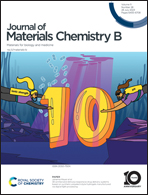Advances of ionic liquid-based nanohybrids for biomedical applications
Abstract
Ionic liquids (ILs) are composed of asymmetric cationic and anionic moieties and are used as green solvents. Their non-toxic nature, favorable biocompatibility and adjustable structure facilitate wide biomedical applications. ILs promote the generation of various nanohybrids that exhibit multiple functions and novel/improved properties with respect to their precursors. Generally, nanostructures have a large specific surface area and abundant functional groups which enable loading and incorporation of ILs through physical interactions or chemical bonding. According to their main skeleton structures, IL-based nanohybrids may be divided into five categories, i.e., poly(ionic liquid)s (PILs), IL-inorganic nanohybrids, IL-metal organic framework nanohybrids (IL-MOF nanohybrids), ILs/carbon materials and ionic materials. These IL-based nanohybrids exhibit various specific features, including thermal responsive behavior, metal chelating, photothermal conversion and antibacterial capabilities. Taking advantage of these characteristics, IL-based nanohybrids may overcome the shortcomings of conventional medicines/drugs and exhibit promising prospects in biomedicine to facilitate controlled drug release, bactericidal treatment and thermotherapy. The present review presents the state-of-the-art progress made in the studies of IL-based nanohybrids in terms of their classifications, structure characteristics, versatile functionalities and biomedical and pharmaceutical applications. The challenges and future perspectives in the developments and applications of IL-based nanohybrids in biomedicine are discussed.

- This article is part of the themed collection: Journal of Materials Chemistry B Recent Review Articles


 Please wait while we load your content...
Please wait while we load your content...